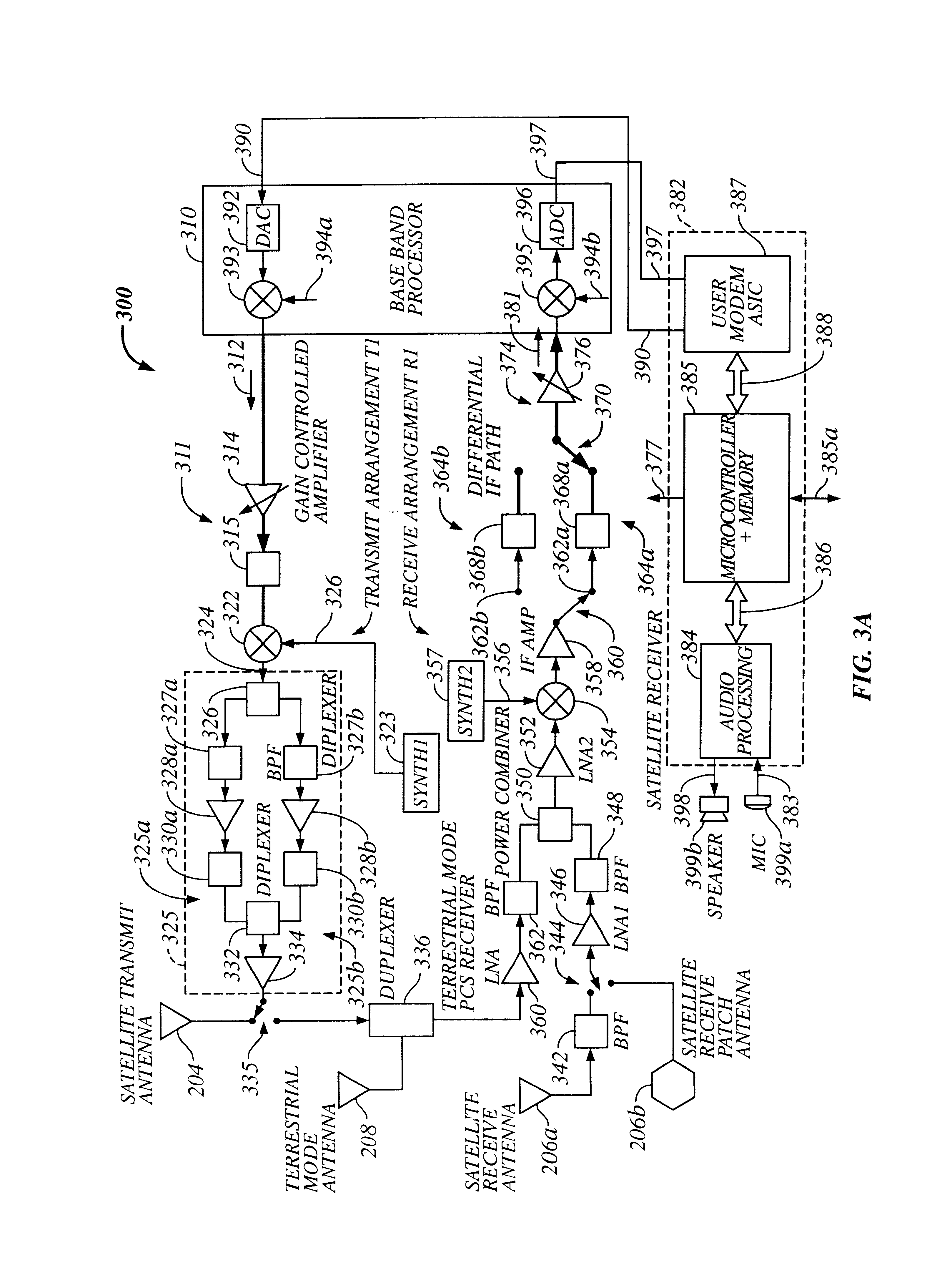Multi-mode satellite and terrestrial communication device
a satellite and terrestrial communication technology, applied in the field of multi-mode satellite and terrestrial communication devices, can solve the problems of inability to provide cellular interoperability, inconvenient installation, and difficulty in achieving unobstructed views
- Summary
- Abstract
- Description
- Claims
- Application Information
AI Technical Summary
Benefits of technology
Problems solved by technology
Method used
Image
Examples
first embodiment
II. WCD First Embodiment
WCD 102 can have many different specific embodiments. FIG. 3a is a detailed block diagram of a WCD 300 useful for implementing WCD 102, according to a first embodiment of the invention.
A. Satellite and Terrestrial Communication Transmit Channels
WCD 300 includes a first transmit arrangement T1 of Satellite and Terrestrial Transmit Channels 214 and 224 (depicted in FIG. 2) to produce RF transmit signals 112 and 124 / 128. With reference to FIG. 3a, Satellite and Terrestrial Transmit Channels 214 and 224 include a common baseband processor (BBP) 310 shared between the channels to produce an IF transmit signal 312 corresponding to either RF satellite signal 112 or terrestrial transmit signals 124 / 128. At any given time, transmit IF signal 312 corresponds to either the satellite transmit signal or the terrestrial transmit signal, but not both. BBP 310 preferably produces IF signal 312 as a differential transmit IF signal at an exemplary IF transmit frequency of 228....
second embodiment
III. WCD Second Embodiment
FIG. 4 is a detailed block diagram of a WCD 400, according to a second embodiment of the invention.
A. Satellite and Terrestrial Communication Transmit Channels
WCD 400 includes a second transmit arrangement T2 of Satellite and Terrestrial Transmit Channels 214 and 224 (depicted in FIG. 2) to produce RF transmit signals 112 and 124 / 128. In Transmit Channels 214 and 224, common transmit IF signal section or path 311 (described above in connection with FIG. 3) provides the amplified, filtered IF signal to an input of an IF routing mechanism, such as an IF switch 404. Switch 404 selectively routes the IF signal produced by IF section 311 to either:
1. a satellite signal up-converter, such as a mixer 406, or
2. a separate terrestrial signal up-converter, such as a mixer 408, depending on whether the IF signal at the switch input corresponds to a satellite or a terrestrial transmit signal, respectively (that is, depending on whether WCD 400 is in the satellite or th...
third embodiment
IV. WCD Third Embodiment
FIG. 5 is a detailed block diagram of a WCD 500, according to a third embodiment of the invention.
WCD 500 includes the first transmit arrangement T1 of Satellite and Terrestrial Transmit Channels 214 and 224, as described above in connection with FIG. 3.
WCD 500 includes a third receive arrangement R3 of Satellite and Terrestrial Receive Channels 216 and 226. The third receive arrangement R3 is similar to the first receive arrangement R1 described above in connection with FIG. 3, except that the third arrangement replaces power combiner 350 of the first receive arrangement with a selectively controlled RF switch 502. RF switch 502 selectively routes either a satellite received RF signal or a terrestrial received RF signal to LNA 352, depending on whether it is desired to receive a satellite or a terrestrial signal.
PUM
 Login to View More
Login to View More Abstract
Description
Claims
Application Information
 Login to View More
Login to View More - R&D
- Intellectual Property
- Life Sciences
- Materials
- Tech Scout
- Unparalleled Data Quality
- Higher Quality Content
- 60% Fewer Hallucinations
Browse by: Latest US Patents, China's latest patents, Technical Efficacy Thesaurus, Application Domain, Technology Topic, Popular Technical Reports.
© 2025 PatSnap. All rights reserved.Legal|Privacy policy|Modern Slavery Act Transparency Statement|Sitemap|About US| Contact US: help@patsnap.com



